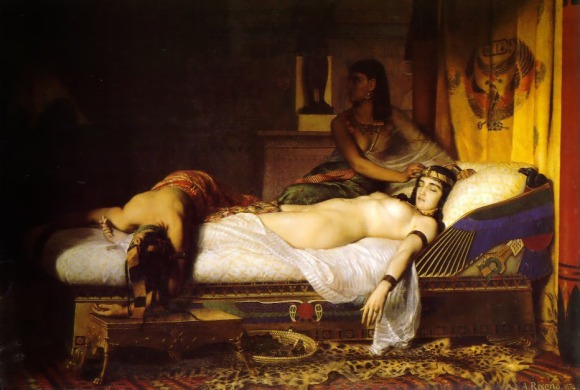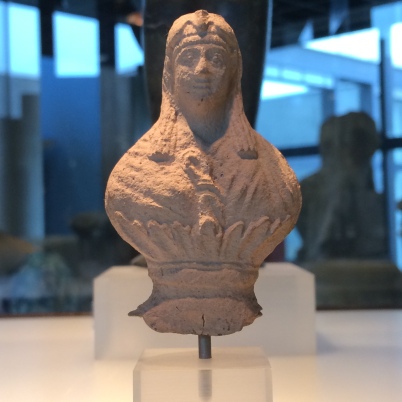The Egyptian mysteries in the novel of Apuleius
Parades and festivities were important parts of religious expression in the ancient world. The religion of Isis was no different.
Background
The Golden Ass (or Metamorphoses) is an ancient novel. It is from a genre commonly called Milesian Tales. These were overarching stories linking episodic events very similar to Picaresque novels. Other famous examples, from a much later period, might include Boccaccoo’s Decameron, Sterne’s Tristram Shandy or even Chaucer’s Canterbury Tales. The best version is the Robert Graves’ translation. It also preshadows post-modernism. Written by Apuelius Lucius, the book tells the tale of Lucius, a man about town who is turned into a donkey by magic. As a donkey he travels around different parts of the Roman world experiencing the world as an animal would. Some of the tales in the book are fantastical, but as a donkey Lucius also meets market sellers, brigands and workers in an oil press.
It is a world recalled in vivid detail.
The goddess Isis
The Golden Ass is made up of eleven books (the size of scrolls, we would probably call them chapters today). In book 11, Lucius (still a donkey) has a vision of the goddess Isis. She tells him to go to a specific space and wait for her procession which will be walking through the town. There he is to eat a bouquet of roses held by the chief priest. The chief priest has also been visited in a dream by the goddess and he holds out the roses to the donkey.
Lucius goes to the site indicated, watches the procession walk past, eats the roses and is turned back into a man.
Following this he is inducted into the mysteries of Isis and Osiris. It is a fascinating, if somewhat strange, conclusion to a book that is charged with eroticism, humour and mild peril.
People walking in the Parade
The German scholar Reinhold Merkelbach talks about the two levels of the novel – the narrative level and the religious level. He says that much of the book has to be simply read as a narrative, but religious elements do come through. The final book of Apuleius’ novel is a valuable source for the parades of Isis.
Apuelius describes how the paraders and people watching it wore their Sunday best “each in finery of their choosing”.
He describes a set of people including the women dressed in white, garlanded with flowers of the spring who walked first. Other women wore mirrors on their back or carried combs. Perhaps the white clothes refer to the linen clothes that Egyptian priests wore, supposedly for purity reasons although it would have been a lot cooler than Wool. In another section, Apuleius is explicit about linen clothes.
They are followed by men and women carrying lamps. We know that lamps are important to the Isis religion. Several have been found portraying the goddess and her fellow Egyptian gods.
The people carrying lamps are followed by musicians playing pipes and flutes, followed by a choir of young people singing a hymn. Perhaps an aretalogy to the goddess.
The scene evoked is one of a community coming together: both the people who worshipped Isis and others in the same city. The wearing of white may have had a similar meaning as it does today, but it may also suggests a form of initiation analogous to baptism.

Precious objects
Apuleius describes the objects carried by the priests in the procession. It is worth describing the passage in full.
The first held a glittering lamp, not like the lamps we use to light our nocturnal feasts but shaped like a golden boat with a tall flame flaring from its central vent.
Lamps were central to the Isiac cults. Light is an obvious symbol of the sun and its life giving powers. Parades with candles and torches at night or in darkened buildings are common. From the description in the novel. The shape of the ship perhaps harks back to Egypt and the ships carried in processions which symbolised the sun’s movement through the sky and harked back the River Nile which was a powerful symbol in the Isiac cults. The procession ends with a ritual involving a ship in the harbour. Isis was many times portrayed with ships and matters of the sea in her guises as Isis-Pelagia and Isis-Euploia.
The second priest carried an altar-top, that is, a source of help, its name auxilia derived from the auxiliary aid the Great Goddess brings.
The altar top is more common to Greek and Roman religious practice, but offerings were also made in Ancient Egyptian processions.
Then the third approached, holding on high a branch of palm its leaves of fine gold, and a caduceus, like Mercury.
During the Roman period, Anubis was regularly portrayed carrying the palm leaves and caduceus of Mercury. The composite figure of Hermanubis draws on the two traditions in a Greek setting.
A fourth showed a cast of a left hand with fingers extended, a symbol of justice, since the left hand’s natural clumsiness, lack of quickness and dexterity, is more appropriate to justice than the right; and he carried a little golden vessel shaped like a woman’s breast, from which he poured milk as a libation.
The cast of a hand is less clear. The Phyrgian god Sabazios was sometimes portrayed as a right hand with lucky charms. He was confused by some Greek writers with the Jewish god and perhaps even Seth. Plutarch writes that the Jews worshipped Dionysius (sometimes identified with Serapis) and Sabazios on the Sabbath.
Justice is one of the qualities which Isis identifies with herself in the aretalogy at Kyme, a key text in the study of Isis.
The jug shaped like a breast is a common symbol connected with worship of Isis. Several such vessels have been found which range in size. The paralell imagery of Isis nursing her son Horus. The milk is a clear connection with this myth. The jugs, and amphora held by the sixth priest, may have been ritual objects holding milk or wine, or even holy “Nile” water. Water seems to have been a central part of the Isiac cults outside of Egypt.
The fifth held a winnowing fan woven from twigs of gold not willow, and a sixth priest bore an amphora.
The winnowing fan is a symbol of power and veneration in ancient Egyptian art.
Gods walking in the parade
The most interesting passage refers to the other gods in the parade.
Behind them came the gods deigning to walk on human feet, firstly Anubis that dread messenger between the powers above and the powers beneath the earth, with a face one side black the other gold, his jackal’s neck erect, bearing a caduceus in his left hand, and a green palm-branch in his right. In his footsteps a priest with proud and measured step carried a statue on his shoulders, a cow seated upright; the cow being a fruitful symbol of the divine Mother of all. Another bore a basket containing secret implements, concealed objects of great sanctity, while a third fortunate priest carried an ancient image of the Great Goddess in the lap of his robe, not in the shape of any beast wild or tame, or bird or human being, but inspiring reverence in its skilled working by its very strangeness, being the ineffable symbol somehow of a deeper sacredness, to be cloaked in awful silence, formed as it was of gleaming gold after this manner: it took the form of a little hollow urn, its surface engraved with Egyptian hieroglyphics, with a rounded base, an extended spout opened slightly like a beak, and a broad curving handle at the opposite side extending backwards deeply from which an asp, coiled in a knot, reared its scaly swollen neck on high.
Anubis was popular across the Roman world. Imagery of him has been found in every province. Cows and bulls are less common, but still wide spread. This passage explicity refers to a female cow. Isis wore bovine horns which she borrowed from the goddess Hathor at some point in the New Kingdom period, when she took over in importance.
The final section of this passage is even more complex. Apuelius obviously wants to evoke a sense of awesome mystery and power. Perhaps the urn is an image of an Osiris Canopus jar. During the Roman period, Osiris Canopus become more widespread. They are stylisied images of Osiris in the shape of a Canopic jar (which were formerly used to contain the innards of the mummified deceased).
The snake may refer to a uraeus snake, which sat on the top of crowns, but it could also be a confused reference to Isis-Thermouthis (more correctly a cobra). The snake is an abiding symbol of Egypt. Cleopatra’s suicide by asp was described by Plutarch.

Initiation into the mysteries of Isis
Following the procession and his miraculous transformation back into a human Apuelius converts to the Isiac cults.
“The people were amazed, and the faithful bowed down before this public manifestation of the power of the great goddess […] and raising their hands to heaven, loudly and with one voice they bore witness to the goddess’s marvellous beneficence.”
He undertakes two initiations. The first initiation to Isis, involves ritual purification in water and an overnight incubation in the temple, where he experiences visions.
The second initiation is to become a follower of Osiris. It costs more money and he must travel to Rome to undertake it.
With my poverty interposing its veto I found myself sorely perplexed, caught, as they say, between the devil and the deep sea. The god continued to press me relentlessly, and his repeated goading, which in the end became a command, was most distressing to me. Eventually by selling my wardrobe, such as it was, I scraped together the small sum that was needed.
This sounds like something from a less scrupulous new religious movement, but most religions need money so perhaps we should be less critical.
This section of the novel makes it sound as if Osiris is the mightier divinity: “most mighty of the great gods, highest of the mighty, greatest of the highest, and ruler of the greatest, Osiris”. Yet this is quite ambiguous, as in most other sources, Osiris or Serapis play secondary roles to Isis.
Apuleius is reticent to share what happened during the ritual of initiation, but both seem to be related to belief in life after death.
For the keys of hell and the guarantee of salvation were in the hands of the goddess, and the initiation ceremony itself took the form of a kind of voluntary death and salvation through divine grace.
His book may be inspired by Christianity which had very explicit beliefs in an afterlife. Earlier texts related to Isis do not mention life after death at all or that prominently.

Summary
It all remains a mystery, but we must be careful not to ascribe too much from Apuelius to the wider cults beyond the time period in which he was writing.




2 replies on “Isis and the Golden Ass”
Reblogged this on Thesseli.
LikeLike
[…] from North Africa. In his mostly humourous book The Golden Ass his hero is saved by Isis, who is portrayed as a powerful and good goddess. Apuleius describes the initiations his hero undertakes involving water purification, overnight […]
LikeLike